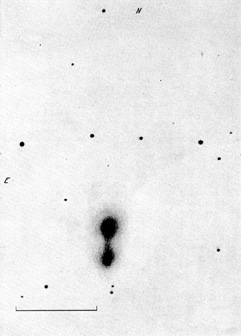


B. NGC 750-751
A photographic reproduction of this system, which is located at R.A. 1h 54m 36s and Decl. +32° 58', is shown in the Plates VII a, b. The general distribution of luminosity in and around the double galaxy is indicated by the shaded and dotted areas of Fig. 4.

|
Plate VIIa. |

|
Plate VII a, b. NGC 750 - 751. Reproduction of a photographic plate obtained with the 200-inch telescope, using Eastman 103a-0 blue sensitive emulsion. Scales = 1' arc. |
Originally this system was known to be simply a connected dumbell nebula, as shown in Plate VII a. The author discovered recently that a long spur from the northern component galaxy points toward the north and curves slightly to the west. This spur terminates near a faint spiral which probably, but not certainly, is a distant background galaxy. Spectral observations of this spiral are planned to decide whether or not it is related to NGC 750 - 751.

|
Figure 4. Distribution of the luminosity in and around NGC 750 - 751. Scale = 1' arc. |
Dr. HUMASON has observed the spectra of our two interconnected globular galaxies. These spectra show only continuum with absorption lines, but no discernible emission lines. The values of Vs for NGC 750 and 751 are respectively equal to 5130 and 5126 km/sec. Using Hubble's scale, the distance of the system is estimated to be 9.7 megaparsecs. Since the apparent photographic magnitude of one of the component galaxies is about mp = +13 its absolute photographic magnitude is of the order of mp = -17.0. Using the mentioned distance, the spur may be about 40000 light years long as projected on a plane normal to the line of sight. On the same scale the diameters of the globular galaxies themselves would only be of the order of 6000 light years. This means that the radiation per unit volume emerging from the central parts of these stellar systems must be very high indeed in order to account for an absolute magnitude mp = -17.0 (or mp = -19 to -20 on one of the more probable new distance scales).
Dumbell double galaxies are actually very frequent. The two central members of the Corona Borealis cluster at R.A. 15h20m2s and Decl. +27° 54' (1950) form one of the most beautiful systems of this type. A second dumbell nebula is found on the outskirts of the same cluster.